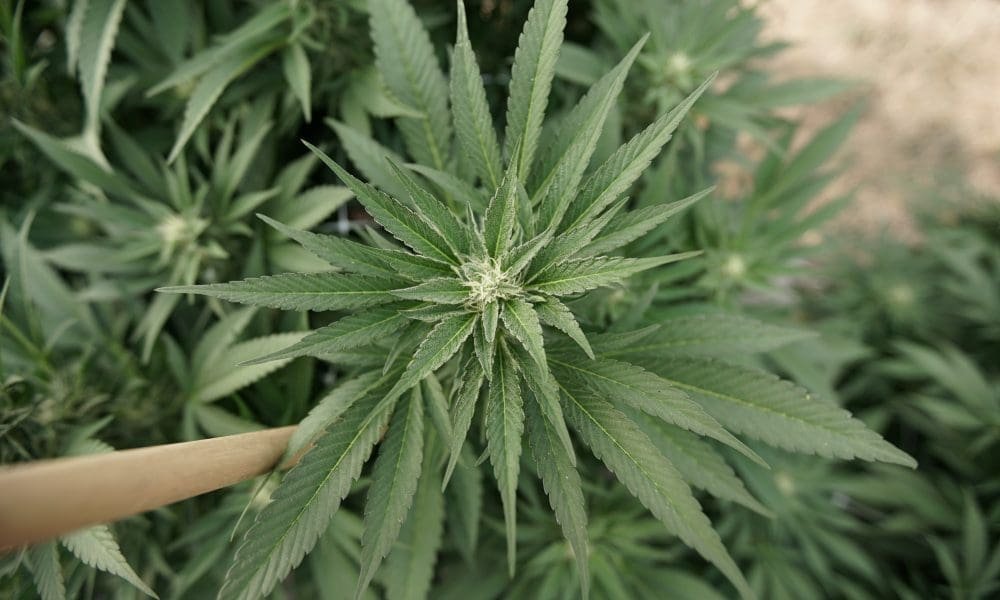In a recent presentation, examining research about the marijuana use by NCAA athletes and student athletes in general, it was found that cannabis has “proven positive results” as an alternative to pain management.
Aquriya Muller, a master’s degree student at Jacksonville State University and the conference speaker, was inspired by published studies on marijuana use among athletes, as well as for pain management.
The National Collegiate Athletic Association has removed marijuana last year from the list of banned substances for Division I Athletes. They stressed that cannabis was not performance-enhancing and should be treated in the same manner as alcohol.
A new research study states that evidence indicates marijuana use by athletes may improve oxygenation in tissues, reduce muscular spasm and help manage pain. For patients suffering from fibromyalgia symptoms, such as stiffness and pain, marijuana usage showed benefits. It also improved relaxation and sleep.
The study also found “marijuana’s anti-inflammatory effects contribute to recovery after exercise and treatment.”
Her presentation cited an example of a Division I athlete who used cannabis to relieve muscle spasms as well as pain, and improve his sleep.
Muller’s report encourages trainers, care providers and other professionals to remain up to date with relevant findings.
The report examined 94 articles in total, but 90 were excluded because they did not meet the criteria for the study.
While Muller acknowledged the apparent positive benefits of marijuana she also identified a requirement for more research. Her conclusion was that most of the research studies were of “lower quality” and “less trustworthy” in general.
In her report, she states: “Contrary to these conclusions, the effectiveness of individual athletes varies.” In addition, there are few concerns regarding behavioral health or performance.
It continues: “Athletic coaches and health care providers must stay informed of the latest evidence and policies to ensure that they can provide evidence-based, tailored care for their patients and athletes.” The knowledge gained from this study will help athletes develop treatment plans that include traditional and non-traditional pain management techniques.
Last year’s NCAA vote to remove marijuana as a banned substance built on a 2022 change that increased the allowable THC threshold for college athletes, a change meant to align NCAA’s rules with those of the World Anti-Doping Agency (WADA).
Athletes in college have historically been tested during the postseason. A positive test could result in a season’s loss of eligibility. The changes were made to concentrate on the problematic usage rather than punishing players for one mistake.
Josh Whitman said that the NCAA drug-testing program was designed to be focused on competition integrity, and cannabis does not give a competitive edge. The council’s main focus is policies that promote student-athlete wellness and health, rather than punishing cannabis users.
When an NCAA committee formally recommending the policy shift in September 2023, it said ending the cannabis ban “acknowledges the ineffectiveness of existing policy (banning, testing and penalizing),” affirms the body’s belief that cannabis is not a “performance-enhancing drug” and promotes the “importance of moving toward a harm-reduction strategy.”
“The timing of discussion and adoption of possible legislation is a decision that will be made by each of three NCAA divisional governance structures,” the panel said. The panel said that the recommendation “is based upon extensive research informed by experts in industry, such as doctors, experts on substance abuse and membership practitioners.”
Several sports organizations are amending their policies on marijuana testing for athletes in response to the legalization of marijuana by states.
For example, the NFL and its players union agreed to end the practice of suspending players over marijuana or other drugs as part of a collective bargaining agreement in 2020.
NFL reached a deal with the players’ union late last year on further reforming its marijuana policy. This included reducing penalties for positive test results and increasing the THC level that players can consume.
NFL has committed significant funding to research into whether CBD can serve as an effective opioid alternative, and it’s also explored the therapeutic potential of the non-intoxicating cannabinoid for pain management and neuroprotection from concussions.
The league announced early last year that it was partnering with Canadian researchers on a clinical trial to test the safety and efficacy of CBD for pain management and neuroprotection from concussions—key issues for many football players who experience injuries as part of the game.
The Ultimate Fighting Championship (UFC) announced in late 2023 that it was formally removing marijuana from its newly modified banned substances list for athletes, also building on an earlier reform.
California’s athletic commission warned that they would still be subject to penalties if they tested positive for THC in excess of the WADA-recommended limit. The state agency is basing its policy on WADA recommendations. UFC subsequently notified participants that the reform didn’t apply under California State Athletic Commission (CSAC) rules.
Nevada sports regulators voted in 2023 to send a proposed regulatory amendment to the governor that would protect athletes from being penalized over using or possessing marijuana in compliance with state law. In October of last year, the regulators adopted this rule.
WADA has faced criticism over the cannabis ban, even though advocates welcomed them. Members of a panel within the agency said in a 2023 opinion piece that marijuana use by athletes violates the “spirit of sport,” making them unfit role models whose potential impairment could put others at risk.
Advocates strongly urged WADA to enact a reform after U.S. runner Sha’Carri Richardson was suspended from participating in Olympics events due to a positive THC test in 2021.
Following that suspension, the U.S. Anti-Doping Agency (USADA) said that the international rules on marijuana “must change,” the White House and then-President Joe Biden himself signaled that it was time for new policies and congressional lawmakers amplified that message.
A NFL player filed a lawsuit against the NFL and his former Denver Broncos in June last year for employment discrimination. The fine was more than $500,000. He claimed that his synthetic cannabinoid prescription was the reason for his positive THC test. In a request to a federal judge, the NFL and Denver Broncos argued that the case should be dismissed.
Meanwhile, the Brooklyn Nets and New York Liberty last year entered into partnerships with a CBD beverage company—the first teams in the NBA and WNBA, respectively, to forge deals with the cannabis industry.
Mynd Drinks – a company that produces hemp-based CBD sparkling beverages – partnered up with the New York clubs. Mynd Drinks made history by becoming an official MLB (Major League Baseball) partner for the Chicago Cubs in 2023.
A study conducted earlier in the year on marijuana and pain found that cannabis, and cannabinoids, could provide useful treatment for different types of chronic discomfort, and reduce or eliminate other pain medications. A paper published in the journal also suggested that certain cannabinoids mixtures could be used to minimize cannabis’s undesirable effects, including THC psychoactivity.
This is just one example of a recent flurry research into cannabis’ use to treat chronic pain. Chronic pain is a common condition that patients with medical marijuana in most states can qualify for.
Research published earlier this year in the journal Pain, for example, found that marijuana was “comparatively more effective than prescription medications” for treating chronic pain after a three-month period, and that many patients reduced their use of opioid painkillers while using cannabis.
According to the authors of the National Cancer Institute, Harvard Medical School, and University of Pittsburgh report, the analysis was able “to determine using causal inference methods that the use of medical cannabis for chronic pain is at least equally effective, and possibly more effective, in relation to patients who have chronic pain and are treated with prescription medication (nonopioid and opioid).
A separate federally funded study found that legalization of marijuana in U.S. states is associated with reduced prescriptions for opioid pain medications among commercially insured adults—indicating a possible substitution effect where patients are choosing to use cannabis instead of prescription drugs to treat pain.
The authors wrote that “these results indicate that the substitution of marijuana for pain medication increases with increased availability of recreational cannabis.” They noted that “there appears to be a slight shift when recreational cannabis is legalized, but that we see better results after users are able to purchase cannabis from recreational dispensaries.”
The paper published in Cannabis explains that “reductions in prescriptions for opioids due to recreational marijuana legalization could prevent opioid exposure in pain patients and lead to a decrease in new opioid users as well as rates of addiction disorder.”
Another recent study also found a decrease in opioid fatal overdoses when marijuana for adults was legalized. That study found a “consistent negative relationship” between legalization and fatal overdoses, with more significant effects in states that legalized cannabis earlier in the opioid crisis. The authors estimated that legalizing recreational marijuana “is associated” with a reduction of approximately 3.5 fatalities per 100,000 people.
The report concluded that, “Our results suggest that expanding recreational marijuana use could be a way to combat the opioid crisis.” The report stated that “previous research shows marijuana can be used to reduce opioid prescriptions and may reduce overdose deaths.”
This effect is heightened with early implementation [recreational marijuana legalization]This relationship appears to be relatively stable over the years,” it said.
Another recently published report into prescription opioid use in Utah following the state’s legalization of medical marijuana found that the availability of legal cannabis both reduced opioid use by patients with chronic pain and helped drive down prescription overdose deaths statewide. It concluded that the results showed “cannabis plays a significant role in pain management, and the reduction of opiate use.”
Yet another study, published in 2023, linked medical marijuana use to lower pain levels and reduced dependence on opioids and other prescription medications. And another, published by the American Medical Association (AMA) last February, found that chronic pain patients who received medical marijuana for longer than a month saw significant reductions in prescribed opioids.
Separate research published found that more than half (57 percent) of patients with chronic musculoskeletal pain said cannabis was more effective than other analgesic medications, while 40 percent reported reducing their use of other painkillers since they began using marijuana.
In Minnesota, meanwhile, a state government report this year on chronic pain patients enrolled in the state’s medical marijuana program said recently that participants “are finding a noticeable change in pain relief” within a few months of starting cannabis treatment.
A large-scale survey of almost 10,000 patients found that a quarter of them who took other drugs to relieve pain reduced their use after trying medical marijuana.
Another new study on the use of medical marijuana by older patients—age 50 and above—concluded that “cannabis seemed to be a safe and effective treatment” for pain and other conditions.
Oprah Highlights Cultural ‘Shift’ Around Psychedelics—But Worries About ‘Losing My Mind’ If She Experimented
Side Pocket Images. Image courtesy Chris Wallis.




